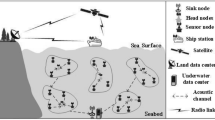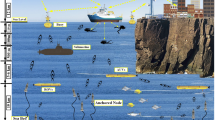Abstract
In the Underwater Wireless Sensor Network (UWSN), the localization of sensor underwater plays a vital role. The underwater sensor gathers information from the earth and transmits the obtained data to the monitoring station. However, the UWSN is facing more serious issues than WSN like long propagation delay, shadow zones, narrow bandwidth, complex geographical environment, high bit error rates, etc. Therefore, the development of effective techniques in UWSN is highly demanded. The reason behind the proposed work is to develop an Energy Consumption-Hybrid Grass Hopper with Cuckoo Search (EC-HGCS) algorithm to mitigate the localization error based on analyzing the parameter of each sensor. The proposed algorithm is a combination of the Grasshopper Optimization Algorithm (GOA) and Cuckoo Search Algorithm (CS). Here, The GOA is improved with the help of the CS algorithm; therefore, highly effective communication can be achieved. The implementation is done in the NS2 platform with some simulation parameters and by comparing the performance metrics like overhead, Packet drops delivery ratio, delay, energy consumption, and throughput with the existing techniques. Eventually, for the proposed approach the throughput and delivery ratio are higher on the other hand energy consumption, overhead, packet drop and delay are lower than in the existing technique.













Similar content being viewed by others
Data availability
All the data is collected from the simulation reports of the software and tools used by the authors. Authors are working on implementing the same using real-world data with appropriate permissions.
Abbreviations
- Xi :
-
Position of ith grasshopper
- Si :
-
Social Interaction of Grasshopper
- Gi :
-
Gravity force on with Grasshopper
- Ai :
-
Wind advection
- d ij :
-
Distance between the ith and jth grasshopper
- s:
-
Strength of social forces
- f:
-
Intensity of attraction
- l:
-
Attractive length scale
- g:
-
Gravitation component
- \( {\hat{e}}_g \) :
-
A unity vector towards the center of the earth
- u:
-
Constant drift
- e ̂w :
-
A unity vector in the direction of the wind
- N:
-
Number of grasshoppers
- n :
-
Nest
- x (t + 1) :
-
Levy flight
- Y σ :
-
Shadowing factor
- 1p :
-
propagation loss exponent
- p 0(e 0):
-
Reference Power
- P re. x(e i):
-
Received Signal Power
- \( \hat{d_i\ } \) :
-
Real Distance
References
Abbasi M, Yaghoobikia M, Rafiee M, Jolfaei A, Khosravi MR (2020) Energy-efficient workload allocation in fog-cloud-based services of intelligent transportation systems using a learning classifier system. IET Intell Transp Syst 14(11):1484–1490
Ahmed S, Ali MT, Alothman AA, Nawaz A, Shahzad M, Shah AA, ..., Shaheen A (2020) EH-UWSN: improved cooperative routing scheme for UWSNs using energy harvesting. J Sens
Ahmed S, Ali MT, Alothman AA, Nawaz A, Shahzad M, Shah AA, Ahmad A, Khan M, Najam Z, Shaheen A (2020) EH-UWSN: improved cooperative routing scheme for UWSNs using energy harvesting. J Sens
Alfouzan FA, Shahrabi A, Ghoreyshi SM, Boutaleb T (2019) A collision-free graph coloring MAC protocol for underwater sensor networks. IEEE Access 7:39862–39878
Awan KM, Shah PA, Iqbal K, Gillani S, Ahmad W, Nam Y (2019) Underwater wireless sensor networks: a review of recent issues and challenges. Wirel Commun Mob Comput 2019:1–20
El Alami H, Najid A (2017) (SET) smart energy management and throughput maximization: A new routing protocol for WSNs. Security Management in Mobile Cloud Computing. IGI Global, 1–28
Feng P, Qin D, Ji P, Zhao M, Guo R, Berhane TM (2019) Improved energy-balanced algorithm for underwater wireless sensor network based on depth threshold and energy level partition. EURASIP J Wirel Commun Netw 2019(1):1–15
Gul H, Ullah G, Khan M, Khan Y (2021) EERBCR: energy-efficient regional-based cooperative routing protocol for underwater sensor networks with sink mobility. J Ambient Intell Hum Comput, 1-13
Hyder W, Nadeem A, Basit A, Rizwan K, Ahsan K, Mehmood N (2017) A review and classification of energy efficient MAC protocols for underwater wireless sensor networks. J Basic Appl Sci 13:63–70
Jouhari M, Ibrahimi K, Tembine H, Benattou M, Ben Othman J (2019) Signaling game approach to improving the MAC protocol in underwater wireless sensor networks. Int J Commun Syst 32(13):e3971
Karim S, Shaikh FK, Aurangzeb K, Chowdhry BS, Alhussein M (2021) Anchor nodes assisted cluster-based routing protocol for reliable data transfer in underwater wireless sensor networks. IEEE Access 9:36730–36747
Mamta N, Goyal N (2021) Localization techniques in underwater wireless sensor network. In 2021 International Conference on Advance Computing and Innovative Technologies in Engineering (ICACITE), pp. 747–751. IEEE
Moon E, Khan MTR, Park H, Ahmed SH, Lee S, Kim D (2019) OMRI–MAC: optimized multi-transmission receiver-initiated MAC in underwater wireless sensor networks. Wirel Pers Commun 107(3):1491–1505
Muzakkari BA, Mohamed MA, Kadir MF, Mohamad Z, Jamil N (2018) Recent advances in energy efficient QoS aware MAC protocols for wireless sensor networks. Int J Adv Comput Res 8(38):212–228.S
Nassiri M, Karimi M, Mohammadi R, Abbasi M (2020) EEARP-an efficient and energy aware routing protocol for underwater wireless sensor networks. ECTI Trans Electric Eng Electron Commun 18(2):145–157
Nguyen NT, Le TT, Nguyen HH, Voznak M (2021) Energy-efficient clustering multi-hop routing protocol in a UWSN. Sensors 21(2):627
Novák M, Křehlík Š, Ovaliadis K (2019) Elements of hyperstructure theory in UWSN design and data aggregation. Symmetry 11(6):734
Poudel S, Moh S (2020) Energy-efficient and fast MAC protocol in UAV-aided wireless sensor networks for time-critical applications. Sensors 20(9):2635
Qin Q, Tian Y, Wang X (2021) Three-dimensional UWSN positioning algorithm based on modified RSSI values mobile information systems
Rahman P, Karmaker A, Alam MS, Hoque MA, Lambert WL (2019) CUMAC-CAM: a channel allocation aware MAC protocol for addressing triple hidden terminal problems in multi-channel UWSNs. SN Appl Sci 1(7):1–20
Roy, A. and Sarma, N., 2021. A synchronous duty-cycled reservation-based MAC protocol for underwater wireless sensor networks Digit Commun Netw, 7(3), 385-398.[10]
Sarang S, Stojanović GM, Stankovski S, Trpovski Ž, Drieberg M (2020) Energy-efficient asynchronous QoS MAC protocol for wireless sensor networks. Wirel Commun Mob Comput 2020:1–13
Su X, Ullah I, Liu X, Choi D (2020) A review of underwater localization techniques, algorithms, and challenges. J Sensors 2020:1–24
Sun N, Wang X, Han G, Peng Y, Jiang J (2021) Collision-free and low-delay MAC protocol based on multi-level quorum system in underwater wireless sensor networks. Comput Commun 173:56–69
Verma A, Kumar S, Gautam PR, Rashid T, Kumar A (2020) Fuzzy logic-based effective clustering of homogeneous wireless sensor networks for a mobile sink. IEEE Sensors J 20(10):5615–5623 [26]
Wan Z, Liu S, Ni W, Xu Z (2019) An energy-efficient multi-level adaptive clustering routing algorithm for underwater wireless sensor networks. Clust Comput 22(6):14651–14660
Wang J, Shen J, Shi W, Qiao G, Wu S, Wang X (2019) A novel energy-efficient contention-based MAC protocol used for OA-UWSN. Sensors 19(1):183
Zafar S, Bashir A, Chaudhry SA (2019) Mobility-aware hierarchical clustering in mobile wireless sensor networks. Ieee access, 7, pp.20394-20403.[27]
Zhang DG, Zhou S, Tang YM (2018) A low-duty cycle efficient MAC protocol based on self-adaption and predictive strategy. Mobile Netw Appl 23(4):828–839
Zhang Z, Shi W, Niu Q, Guo Y, Wang J, Luo H (2019) A load-based hybrid MAC protocol for underwater wireless sensor networks. IEEE Access 7:104542–104552
Author information
Authors and Affiliations
Corresponding author
Ethics declarations
Conflict of interest
The authors declare that they have no conflict of interest.
Additional information
Publisher’s note
Springer Nature remains neutral with regard to jurisdictional claims in published maps and institutional affiliations.
Rights and permissions
Springer Nature or its licensor (e.g. a society or other partner) holds exclusive rights to this article under a publishing agreement with the author(s) or other rightsholder(s); author self-archiving of the accepted manuscript version of this article is solely governed by the terms of such publishing agreement and applicable law.
About this article
Cite this article
Ramesh, B., Bhandari, B.N. & Pothalaiah, S. A hybrid technique to provide effective allocation based on mac with UWSN for energy efficiency and effective communication. Multimed Tools Appl 82, 28977–28996 (2023). https://doi.org/10.1007/s11042-023-14897-x
Received:
Revised:
Accepted:
Published:
Issue Date:
DOI: https://doi.org/10.1007/s11042-023-14897-x




